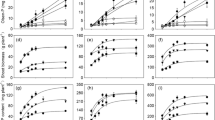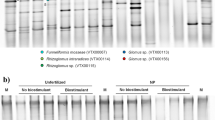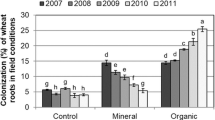Abstract
Maize plants were grown in an autoclaved quartz sand–soil mix to which the bacterial communities of the soil and the mycorrhizal inocula were reintroduced. The root systems of the plants were divided with the two halves growing in separate pots. There were five different treatments: plants with both root halves non-mycorrhizal either at high or low P availability (nm-nm HP and nm-nm LP) or mycorrhizal plants grown at low P availability with one side of the root system non-mycorrhizal while the other side was inoculated with Glomus intraradices (GI-nm) or G. mosseae (GM-nm) or plants with both sides mycorrhizal but each side inoculated with a different fungus (GI–GM). The plants were harvested after 3 or 6 weeks. Shoot dry weight and shoot P concentration of the nm-nm HP plants were always higher than the plants grown at low P supply. Acid phosphatase activity in the rhizosphere was similar in all treatments and did not change over time. However, after 6 weeks alkaline phosphatase activity was higher in the rhizosphere of both root halves in the mycorrhizal plants as compared to the non-mycorrhizal plants. Mycorrhizal colonisation increased from 15–34% after 3 weeks to 78–87% after 6 weeks with no significant difference between GI and GM. The bacterial community structure, assessed by denaturing gradient gel electrophoresis (DGGE), changed over time and was specific for each of the three compartments, non-rhizosphere soil, rhizosphere soil and root surface. While the two P levels in the non-mycorrhizal treatments had no significant effect on the bacterial communities, mycorrhizal colonisation changed the bacterial community structure on the root surface and in the non-rhizosphere soil. The bacterial communities of the GI–GM plants differed more from the non-mycorrhizal plants than those of the plants with only one half of the root system mycorrhizal. The bacterial communities of both root halves of the GI-nm plants did not differ from each other and were very similar to those of the non-mycorrhizal plants. After 3 weeks, the bacterial communities of the two sides of the GM-nm plants differed: the mycorrhizal side of the resembled that of the GI–GM plants, while the non-mycorrhizal side of the root system was similar to that of the nm-nm plants. However after 6 weeks, the bacterial community structures of the two sides of the root system of the GM-nm plants were similar and differed from those of the nm-nm plants. It is concluded that the effect of mycorrhizal colonisation on the bacterial community structure in the rhizosphere may, at least in part, be plant-mediated.
Similar content being viewed by others
References
Amann R I, Ludwig W and Schleifer K H 1995 Phylogenetic identi-fication and in situ detection of individual microbial cells without cultivation. Microbiol. Rev. 59, 143-169.
Andrade G, Mihara K L, Linderman R G and Bethlenfalvay G J 1997 Bacteria from rhizosphere and hyphosphere soils of different arbuscular mycorrhizal fungi. Plant Soil 192, 71-79.
Andrade G, Linderman RG and Bethlenfalvay GJ 1998 Bacterial associations with the mycorhizosphere and hyphosphere of the arbuscular mycorrhizal fungus Glomus mosseae. Plant Soil 202, 79-87.
Aulakh M S, Wassmann R, Bueno C, Kreuzwieser J and Rennenberg H 2001 Characterization of root exudates at different growth stages of ten rice (Oryza sativa L.) cultivars. Plant Biol. 3, 139-148.
Bago B and Azcon-Aguillar C 1997 Changes in the rhizosphere pH induced by arbuscular mycorrhiza formation in onion (Allium cepa L.). Z. Pflanzenernaehr. Bodenkd. 160, 333-339.
Becker D M, Bagley S T and Podila G K 1999 Effects of mycorrhizal-associated Streptomyces on growth of Laccaria bicolor, Cenococcum geophilum, and Armillaria species and on gene expression in Laccaria bicolor. Mycol. 91, 33-40.
Bianciotto V, Bandi C, Minerdi D, Sironi M, Tichy H V and Bonfante P 1996 An obligately endosymbionitic mycorrhizal fungus itself habors obligately intracellular bacteria. Appl. Environ. Microbiol. 62, 3005-3010.
Buwalda J G and Goh K M 1982 Host-fungus competition for carbon as a cause of growth depressions in vesicular-arbuscular mycorrhizal ryegrass. Soil Biol. Biochem. 14, 103-106.
Christensen H and Jakobsen I 1993 Reduction of bacterial growth by a vesicular-arbuscular mycorrhizal fungus in the rhizosphere of cucumber (Cucumis sativus L.). Biol. Fertil. Soils 15, 253-258.
Dixon R K, Garrett H E and Cox G S 1989 Boron fertilization, vesicular-arbuscular mycorrhizal colonization and growth of Citrus jambhiri Lush. J. Plant Nutr. 12, 687-700.
Dodd J C, Burton C C, Burns R G and Jeffries P 1987 Phosphatase activity associated with the roots and the rhizosphere of plants infected with vesicular-arbuscular mycorrhizal fungi. New Phytol. 107, 163-172.
Eissenstat D M, Graham J H, Syvertsen J P and Drouillard D L 1993 Carbon economy of sour orange in relation to mycorrhizal colonization and phosphorus status. Ann. Bot. 71, 1-10.
Fillion M, St-Arnaud M and Fortin J A 1999 Direct interaction between the arbuscular mycorrhizal fungus Glomus intraradices and different rhizosphere micro-organisms. New Phytol. 141, 525-533.
Gagliardi J V, Buyer J S, Angle J S and Russek-Cohen E 2001 Structural and functional analysis of whole-soil microbial communities for risk and efficacy testing following microbial inoculation of wheat roots in diverse soils. Soil Biol. Biochem. 33, 25-40.
Giovannetti M and Mosse B 1980 An evaluation of techniques for measuring vesicular-arbuscular mycorrhizal infection in roots. New Phytol. 84, 489-500.
Graham J H, Leonard R T and Menge J A 1981 Membrane-mediated decrease of root-exudation responsible for phosphorus inhibition of vesicular-arbuscular mycorrhiza formation. Plant Physiol. 68, 548-552.
Heuer H, Krsek M, Baker P, Smalla K and Wellington E M H 1997 Analysis of actinomycete communities by specific amplification of genes encoding 16S rRNA and gel-electrophoretic separation in denaturing gradients. Appl. Environ. Microbiol. 63, 3233-3241.
Joner E J and Jakobsen I 1995 Growth and extracellular phosphatase activity of arbuscular mycorrhizal hyphae as influenced by soil organic matter. Soil Biol. Biochem. 27, 1153-1159.
Joner E J and Johansen A 2000 Phosphatase activity of external hyphae of two arbuscular mycorrhizal fungi. Mycol. Res. 104, 81-86.
Jongman R H, ter Braak, C J F and Van Tongeren O F R (Eds.) 1995 Data Analysis in Community and Landscape Ecology. Cambridge University Press, Cambridge, UK.
Kim K Y, Jordan D and Macdonald G A 1998 Effect of phosphatesolubilizing bacteria and vesicular-arbuscular mycorrhizae on tomato growth and soil microbial activity. Biol. Fertil. Soils 26, 79-87.
Koide R T and Kabir Z 2000 Extraradical hyphae of the mycorrhizal fungus Glomus intraradices can hydolyse organic phosphate. New Phytol. 148. 511-517.
Kucey R M N and Paul E A (1982) Carbon flow, photosynthesis, and N2 fixation in mycorrhizal and nodulated faba beans (Vicia faba L.). Soil Biol. Biochem. 14, 407-412.
Margesin R (1993) Bestimmung der alkalischen und sauren Phosphatase. In Bodenbiologische Arbeitsmethoden. Eds. F Schinner, R Öhlinger, E Kandeler and R Margesin. pp. 200-203. Springer, Berlin.
Marschner P and Crowley D E 1996 Physiological activity of a bioluminescent Pseudomonas fluorescens (strain 2-79) in the rhizosphere of mycorrhizal and non-mycorrhizal pepper (Capsicum annuum L.). Soil Biol. Biochem. 28, 869-876.
Marschner P, Crowley D E and Higashi R M 1997 Root exudation and physiological status of a root-colonizing flourescent pseudomonad in mycorrhizal and non-mycorrhizal pepper (Capsicum annuum L.). Plant Soil 189, 11-20.
Marschner P, Yang C-H, Lieberei R and Crowley D E 2001a Soil and plant specific effects on bacterial community composition in the rhizosphere. Soil Biol. Biochem. 33, 1437-1445.
Marschner P, Crowley D E and Lieberei R 2001b Arbuscular mycorrhizal infection changes the bacterial 16S rDNA community composition in the rhizosphere of maize. Mycorrhiza 11, 297-302.
Meyer J R and Linderman R G 1986 Selective influence on populations of rhizosphere or rhizoplane bacteria and actinomycetes by mycorrhizas formed byGlomus fasciculatum. Soil Biol. Biochem. 18, 191-196.
Murphy J and Riley J P 1962 A modified solution method for the determination of phosphate in natural waters. Anal. Chim. Acta 27, 31-36.
Muyzer G and Smalla K 1998 Application of denaturing gradient gel electrophoresis (DGGE) and temperature gradient gel electrophoresis (TGGE) in microbial ecology. Antonie van Leeuwenhoek 73, 127-141.
Paulitz T C and Linderman R G 1989 Interactions between fluorescent pseudomonads and VA mycorrhizal fungi. New Phytol. 113, 37-45.
Poole E J, Bending G D, Whipps J M and Read D J 2001 Bacteria associated with Pinus sylvestris-Lactarius rufus ectomycorrhizas and their effects on mycorrhizal formation in vitro. New Phytol. 151, 743-751.
Posta K, Marschner H and Römheld V 1994 Manganese reduction in the rhizosphere of mycorrhizal and non-mycorrhizal maize. Mycorrhiza 5, 119-124.
Shachar-Hill Y, Pfeffer P E, Douds D, Osman S F, Doner L W and Ratcliffe R G 1995 Partitioning of intermediary carbon metabolism in vesicular-arbuscular mycorrhizal leek. Plant Physiol. 108, 7-15.
Sheffield V C, Cox D R, Lerman L S and Myers R M 1989Attachment of a 40-base-pair G+C-rich sequence (GC-clamp) to genomic DNA fragments by the polymerase chain reaction results in improved detection of single-base changes. Proc. Natl. Acad. Sci. USA 86, 232-236.
Tarafdar J C and Marschner H 1994 Phosphatase activity in the rhizosphere and the hyphosphere of VA mycorrhizal wheat supplied with inorganic and organic phosphorus. Soil Biol. Biochem. 26, 387-395.
Vazquez M M, Cesar S, Azcon R and Barea J M 2000 Interactions between arbuscular mycorrhizal fungi and other microbial inoculants (Azospirillum, Pseudomonas, Trichoderma) and their effects on microbial population and enzyme activities in the rhizosphere of maize plants. Appl. Soil Ecol. 15, 261-272.
Vetterlein D, Bergmann C and Huettl R F 1999 Phosphorus availability in different types of open-cast spoil and the potential impact of organic matter application. Plant Soil 213, 189-194.
Author information
Authors and Affiliations
Corresponding author
Rights and permissions
About this article
Cite this article
Marschner, P., Baumann, K. Changes in bacterial community structure induced by mycorrhizal colonisation in split-root maize. Plant and Soil 251, 279–289 (2003). https://doi.org/10.1023/A:1023034825871
Issue Date:
DOI: https://doi.org/10.1023/A:1023034825871




